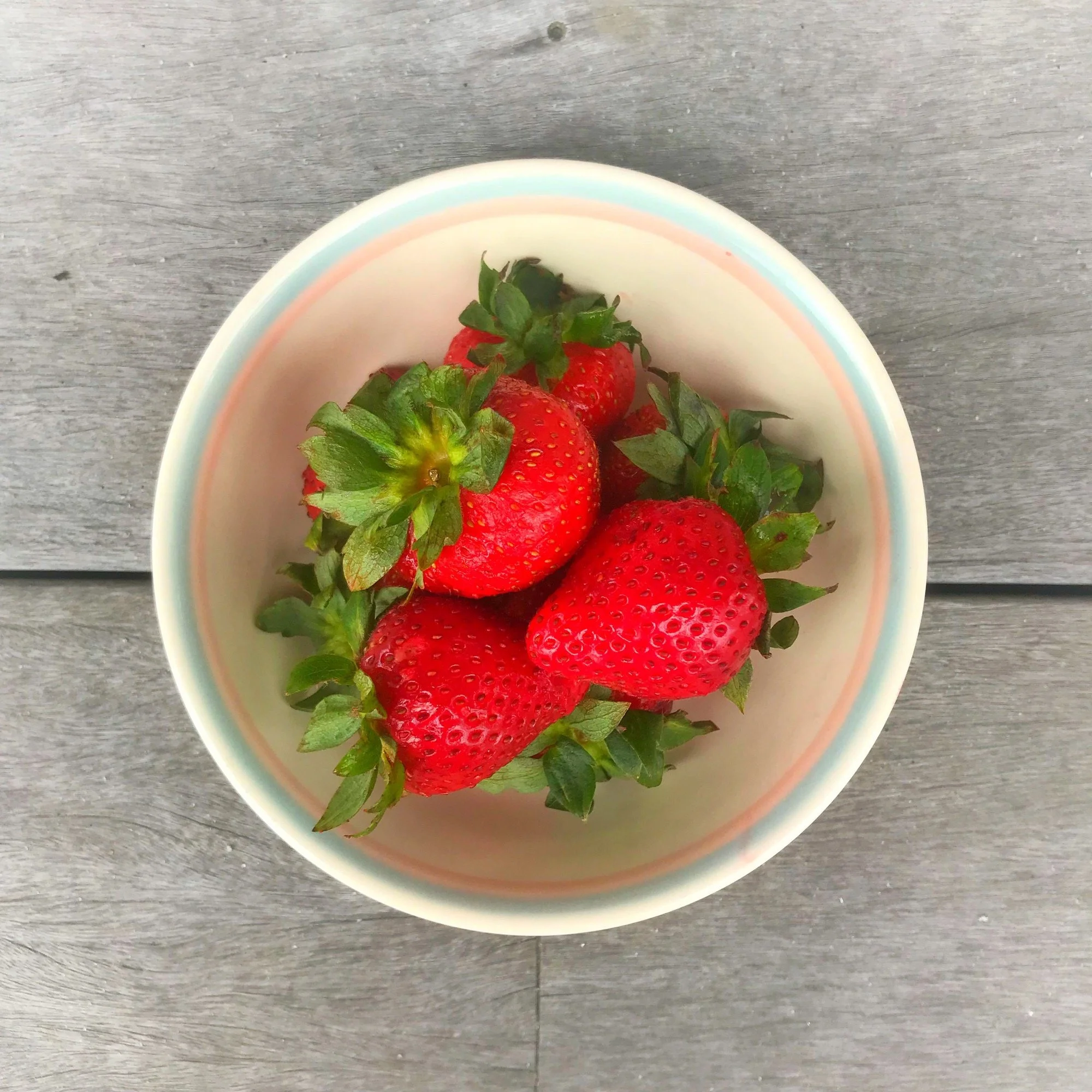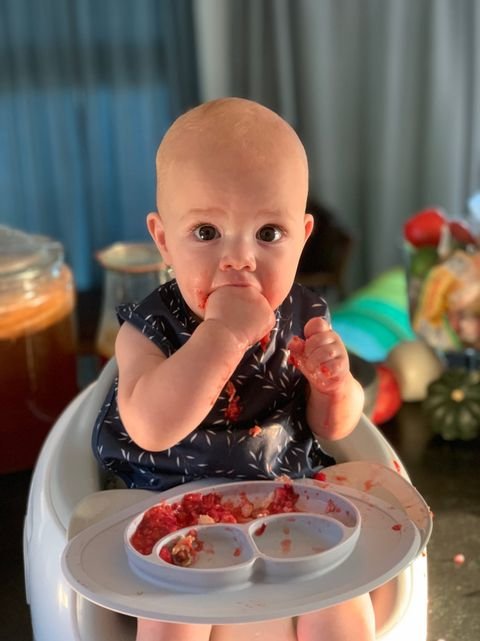What You Need to Know About Strawberries and Baby-Led Weaning
How can strawberries be safe for baby-led weaning?
Won’t babies choke?
Aren’t strawberries a common food allergen?
Not too long ago, I got a direct message on Instagram from a mom who was confused about how strawberries could be safe for babies. She was concerned after hearing of a choking incident in her area involving one.
Strawberries are one of those foods where the texture often needs to be modified for babes, because food texture plays a huge role in reducing choking risk.
In general, early finger foods should be soft and easily smashed between the thumb and forefinger.
The good news about very ripe strawberries is that their texture is easy to mash down with the gums, reducing choking risk. But many strawberries are too hard for babies, especially if there are any white or green parts.
Keep reading to learn more about strawberries and baby-led weaning and how to safely serve strawberries to a baby.
Can Babies Have Strawberries?
Yes! Strawberries (with some slight modifications in size and texture) are one of the best fruits for babies. They're packed with antioxidants, vitamin C, and fiber and tend to be lower in natural sugars than many fruits.
(Although natural sugars found in dairy, fruit, and vegetables are totally fine and nothing to worry about. There's no need to avoid natural sugars. The recommendation is to avoid added sugars for babies younger than 24 months of age.)
Even with all the nutrients and delicious flavors strawberries have to offer, caregivers are often concerned about offering this fruit to babies. So let's dive into the most common reasons why parents worry about babies eating strawberries.
Are strawberries a highly allergenic food?
First, let's start with the myth that strawberries are a highly allergenic food. Understandably, concerns about allergies stop many parents from offering this nutrient-rich fruit to kids.
10-month old baby girl using her pincer grasp to pick up cut strawberries! Thank you to her kind parents for allowing me to share.
The truth is, while food allergies to strawberries can happen, they are not common. Talk to your pediatrician about introducing strawberries to your baby if you are concerned, but know that the risk of an allergy to strawberries is very low.
So where did the myth about strawberries and allergies come from?
Some babies develop a rash around the mouth after eating strawberries. It can appear alarming, but the irritation is more likely caused by the fruit’s acidity coming in contact with the baby’s delicate skin, not an allergic reaction.
One way to help prevent this harmless skin reaction is to coat the skin of the baby’s face, chin and mouth area with an emollient like Aquaphor before meals, to help form a barrier and prevent the rash.
If you notice this happening frequently, you can try alternating acidic fruits like strawberries with less acidic fruits like bananas or peaches.
Are strawberries a choking hazard for babies?
There's a potential risk of choking with any whole fruit or vegetable, especially when they're raw.
But there are easy ways to modify strawberries so they are a safe food for your baby.
For example, you can cut strawberries into very thin slices or small pieces (about the size of a fingernail), or mash them into a puree, or defrost previously frozen strawberries which softens the texture and makes the texture smooshy.
All of these tips make serving strawberries less of a choking hazard.
Strawberries have an inedible stem and some have a harder, white, pulpy center.
Reduce choking risk by cutting a strawberry in half for a baby still using the palmar grasp, then remove the stem and core (or remove) the harder, white center (a paring knife works well for this job!)
Example of a 6-month old boy eating mashed-pureed strawberries, which can reduce the risk of choking! Big thanks to his parents for sharing.
Can babies have strawberries as finger food?
The best baby-led weaning foods are foods that are cut to the right size so that a baby can pick them up and self-feed on their own.
I love strawberries as a finger food because they’re naturally a safe size for most babies, as long as they are soft. You may need to slice the strawberries depending on your baby's age and stage of development.
Serving whole, super-ripe strawberries to ~6-month-olds during baby led weaning works best for many babies.
At this stage, most babies are using a palmar grasp, and it’s easier for them to hold the fruit in their fist while noshing on the whole berry.
You can slice or chop the strawberries into thin slices or fingernail-sized small pieces for babies 7-12 months, once they’re able to use their thumb and forefinger to pick up small bite sized pieces.
No matter what foods you offer your little one, be sure to stick close by and supervise closely during meals.
What are the Benefits of Strawberries for Babies?
As a children’s nutrition expert, I encourage parents to offer a variety of fruits and veggies from the beginning and role model eating these healthy foods right along with the baby.
Fruits and vegetables are loaded with vitamins and minerals we need for good health, and when we eat a variety of them, we’re more likely to benefit from the spectrum of nutrients they contain.
I don’t like to play favorites…
…but some fruits and veggies stand out as more valuable sources of key nutrients. Berries fall into that category!
(This kiddo above is my youngest!)
Here are a few reasons why strawberries are so nutritious:
Iron absorption
Strawberries are bursting with vitamin C, which helps the body absorb non-heme iron.
Heme and non-heme iron are two types of iron. Heme iron is found in meat and animal foods, and non-heme iron is found in plant sources of iron, including beans, fortified cereals, seeds, and some leafy greens.
For all my plant-based eaters out there, non-heme iron isn't absorbed as well as heme iron. And iron is a crucial nutrient for growth and development during infancy and childhood.
So, pair vitamin C foods like strawberries with iron-rich foods to help increase your baby's iron absorption from those non-heme iron sources.
Immunity
A sweet 7-month old baby girl chewing on a previously frozen, defrosted strawberry! Shout out to her parents for sharing this cutie!
Vitamin C's better-known role is supporting the health of the immune system. The Dietary Reference Intakes (DRIs) are not established for 6-month-olds since babies get most of their nutrition from breast milk or formula. But babies and toddlers 1 to 3 years old need about 15 mg of vitamin C daily.
If you offer one strawberry for your little one to snack on, they’ll get 10.6 mg of vitamin C!
But it's not only the vitamin C in strawberries that strengthens immunity.
Berries are also loaded with phytochemicals–antioxidants. A recent review found that most berries increased antioxidant levels in the body.
The studies also showed that berries altered the gut microbiota composition so that the good bacteria increased and the harmful bacteria decreased. A healthy gut is another factor in keeping the immune system strong.
Teething relief
Babies love the cool temp of defrosted (previously frozen) strawberries and find it soothing on sore gums.
There are several ways to offer strawberries to relieve your babe's sore gums. You can let them gum the whole berry. Or puree the fruit and freeze it into popsicles using a popsicle mold.
The cold temp will numb their gums, and the chewing action gives them some relief.
Defrosted, previously frozen strawberries have a softer texture and can help soothe a baby’s sore gums during periods of teething. Be sure they are defrosted enough to be squishy before serving.
Quick Tips for Serving Strawberries to Babies
I love offering strawberry–chopped, mashed, and spread on toast that is topped with a thin layer of almond butter or creme fraiche. Or added to yogurt or chia seed pudding or baked into muffins. So many nutritious options!
If you’re wondering how to give strawberry to your baby, here are a few more quick tips:
Avoid serving if under-ripe or overly firm
For babies using a pincer grasp, cut into small chickpea-sized bites
For babies using a palmar grasp, trim stem and leaves and offer soft and cut in half
If the berry is too firm, freeze and thaw to soften up the texture
Have you tried giving strawberries to your baby? Let me know in the comments below.
If you’re getting ready to start your baby on solids, download my FREE Baby-Led Feeding Essential Checklist to make sure you have everything you need to get started. You might also want to check out my online course for parents, based on my best-selling book which will walk you through the whole process of starting solids using a baby-led approach.
Alternatively, if your baby is almost ready to start solids and you’re looking for someone you trust to map out the entire first 12 weeks of your baby’s solid food feeding journey, check out my new Safe & Simple 12 Week Meal Plan!
Over 30 recipes, weekly shopping lists, tons of balanced baby meals, a complete plan for top allergen introduction, & lots of guidance (with photos) on how to safely serve each food.
And if you're looking for personalized nutrition support for yourself, your babies and/or your kids, I am currently accepting new clients in my virtual private practice. Looking forward to meeting you online…









